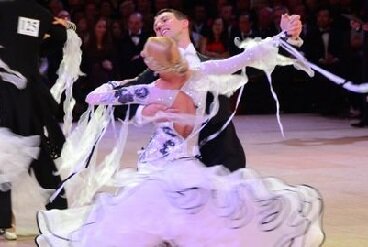Make your Basic Standard
Look Advanced 
24 August 2016
There is a marked difference between Syllabus and Open level dancing in Standard, and dancers still progressing through the Syllabus can feel that it inhibits them from showing their full potential. However, there are certain stylistic ways of dancing figures that will make your basic Syllabus routines appear as if they are complex Open routines, while still being legal in Syllabus competitions and without you even having to change your choreography. This is possible in Waltz, Tango, and Quickstep, since even advanced Foxtrot and Viennese Waltz are similar or identical to Syllabus.
Waltz Hesitation Change
This Bronze Waltz figure is extremely simple (see the technical description here), but with a slight modification, it can look like an advanced figure. It essentially consists of steps 1-3 of a Natural Turn, followed by a Heel Pull, with the Man ending having maintained weight on his RF (Lady LF), but that Heel Pull can be made to look like a Right Lunge. If you are unfamiliar with the Right Lunge, check out , which shows it in slow motion. Remember, the Right Lunge is not allowed in Syllabus dancing, so we are making the Hesitation Change look like a Right Lunge.
On step 5, the Man will take a wide step to the right into a flexed knee, shaping to the left, causing the Lady to turn her head to her right. On step 6, you may either to maintain that Sway, or change it to the right (Lady left). If the Sway is maintained, the Lady's head will remain to her right until the second step of the following figure. If the Sway is changed, the Lady's head will follow that change in Sway. Unlike the actual Right Lunge, this will only last for three beats.
Tango Back Corte
This is another extremely simple Syllabus figure (see the technical description here) that can look phenomenal if done with a stylistic flare. The Back Corte consists of four steps, but the second, third, and fourth steps are essentially a Closed Finish (although an Open Finish may be substituted), but by embellishing the first step, we can make this PreBronze figure look like a Spanish Drag. If you are unfamiliar with the Spanish Drag, check out , which shows it danced by current Professional World Finalists Victor and Anastasia. Remember, the Spanish Drag is not allowed in Syllabus dancing, so we are making the Back Corte look like a Spanish Drag.
On Step 1, the Man will create an impulse through the body and frame, which will cause the Lady to rebound off of him and leave her head far to the left as she steps to the right with him. The movement should be sharp and fast, with a distinct almost total freeze before step 2. From here, all the flash is over, and steps 2-4 will be the regular steps of the Back Corte. Unlike the actual Spanish Drag, there is no option for the Man and Lady to look at each other and slowly come back together.
Quickstep Six Quick Run
This figure only becomes allowable at the Gold level (see the technical description here), but many Gold dancers aren't using this figure to its full potential. Of all the dances, Quickstep differs most between Syllabus and Open, because hops and runs are introduced. If you don't know what I mean by this, check out and notice all the hopping and running, which is probably absent from your Syllabus routine. Almost every figure in the Quickstep Syllabus is danced with the same sort of smooth action as Waltz, but the Six Quick Run is one of the few figures that allows you to use this Advanced running and hopping action within the Syllabus.

Each step of the Six Quick Run should be danced not with a smooth action, but with a hopping action. Think of it like hopscotch: on each step, you are hopping into a box drawn on the floor, even on the locking action of the figure. The difficult part is coordinating your bounce with your partner's, but if you can do that while still dancing Gold, you will likely be the only ones on the floor with the looks of an advanced couple. This can also be used in the Quicks of the Four Quick Run, but be careful using it elsewhere, as invigilators might disapprove.